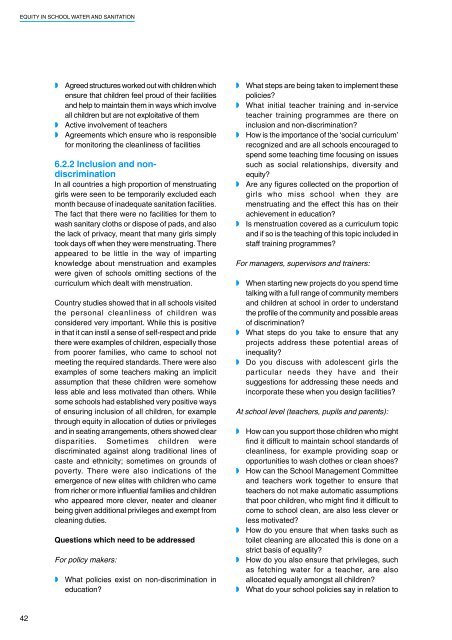Equity in School Water and Sanitation
Equity in School Water and Sanitation
Equity in School Water and Sanitation
Create successful ePaper yourself
Turn your PDF publications into a flip-book with our unique Google optimized e-Paper software.
EQUITY IN SCHOOL WATER AND SANITATIONAgreed structures worked out with children whichensure that children feel proud of their facilities<strong>and</strong> help to ma<strong>in</strong>ta<strong>in</strong> them <strong>in</strong> ways which <strong>in</strong>volveall children but are not exploitative of themActive <strong>in</strong>volvement of teachersAgreements which ensure who is responsiblefor monitor<strong>in</strong>g the cleanl<strong>in</strong>ess of facilities6.2.2 Inclusion <strong>and</strong> nondiscrim<strong>in</strong>ationIn all countries a high proportion of menstruat<strong>in</strong>ggirls were seen to be temporarily excluded eachmonth because of <strong>in</strong>adequate sanitation facilities.The fact that there were no facilities for them towash sanitary cloths or dispose of pads, <strong>and</strong> alsothe lack of privacy, meant that many girls simplytook days off when they were menstruat<strong>in</strong>g. Thereappeared to be little <strong>in</strong> the way of impart<strong>in</strong>gknowledge about menstruation <strong>and</strong> exampleswere given of schools omitt<strong>in</strong>g sections of thecurriculum which dealt with menstruation.Country studies showed that <strong>in</strong> all schools visitedthe personal cleanl<strong>in</strong>ess of children wasconsidered very important. While this is positive<strong>in</strong> that it can <strong>in</strong>stil a sense of self-respect <strong>and</strong> pridethere were examples of children, especially thosefrom poorer families, who came to school notmeet<strong>in</strong>g the required st<strong>and</strong>ards. There were alsoexamples of some teachers mak<strong>in</strong>g an implicitassumption that these children were somehowless able <strong>and</strong> less motivated than others. Whilesome schools had established very positive waysof ensur<strong>in</strong>g <strong>in</strong>clusion of all children, for examplethrough equity <strong>in</strong> allocation of duties or privileges<strong>and</strong> <strong>in</strong> seat<strong>in</strong>g arrangements, others showed cleardisparities. Sometimes children werediscrim<strong>in</strong>ated aga<strong>in</strong>st along traditional l<strong>in</strong>es ofcaste <strong>and</strong> ethnicity; sometimes on grounds ofpoverty. There were also <strong>in</strong>dications of theemergence of new elites with children who camefrom richer or more <strong>in</strong>fluential families <strong>and</strong> childrenwho appeared more clever, neater <strong>and</strong> cleanerbe<strong>in</strong>g given additional privileges <strong>and</strong> exempt fromclean<strong>in</strong>g duties.Questions which need to be addressedFor policy makers:What policies exist on non-discrim<strong>in</strong>ation <strong>in</strong>education? What steps are be<strong>in</strong>g taken to implement thesepolicies? What <strong>in</strong>itial teacher tra<strong>in</strong><strong>in</strong>g <strong>and</strong> <strong>in</strong>-serviceteacher tra<strong>in</strong><strong>in</strong>g programmes are there on<strong>in</strong>clusion <strong>and</strong> non-discrim<strong>in</strong>ation? How is the importance of the ‘social curriculum’recognized <strong>and</strong> are all schools encouraged tospend some teach<strong>in</strong>g time focus<strong>in</strong>g on issuessuch as social relationships, diversity <strong>and</strong>equity? Are any figures collected on the proportion ofgirls who miss school when they aremenstruat<strong>in</strong>g <strong>and</strong> the effect this has on theirachievement <strong>in</strong> education? Is menstruation covered as a curriculum topic<strong>and</strong> if so is the teach<strong>in</strong>g of this topic <strong>in</strong>cluded <strong>in</strong>staff tra<strong>in</strong><strong>in</strong>g programmes?For managers, supervisors <strong>and</strong> tra<strong>in</strong>ers:When start<strong>in</strong>g new projects do you spend timetalk<strong>in</strong>g with a full range of community members<strong>and</strong> children at school <strong>in</strong> order to underst<strong>and</strong>the profile of the community <strong>and</strong> possible areasof discrim<strong>in</strong>ation?What steps do you take to ensure that anyprojects address these potential areas of<strong>in</strong>equality?Do you discuss with adolescent girls theparticular needs they have <strong>and</strong> theirsuggestions for address<strong>in</strong>g these needs <strong>and</strong><strong>in</strong>corporate these when you design facilities?At school level (teachers, pupils <strong>and</strong> parents):How can you support those children who mightf<strong>in</strong>d it difficult to ma<strong>in</strong>ta<strong>in</strong> school st<strong>and</strong>ards ofcleanl<strong>in</strong>ess, for example provid<strong>in</strong>g soap oropportunities to wash clothes or clean shoes?How can the <strong>School</strong> Management Committee<strong>and</strong> teachers work together to ensure thatteachers do not make automatic assumptionsthat poor children, who might f<strong>in</strong>d it difficult tocome to school clean, are also less clever orless motivated?How do you ensure that when tasks such astoilet clean<strong>in</strong>g are allocated this is done on astrict basis of equality?How do you also ensure that privileges, suchas fetch<strong>in</strong>g water for a teacher, are alsoallocated equally amongst all children?What do your school policies say <strong>in</strong> relation to42












